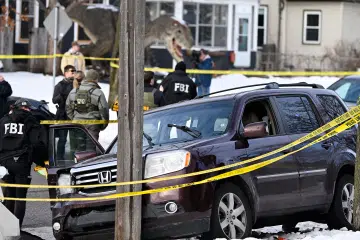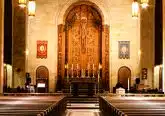Catholic cemetery needs help combating invasive pests
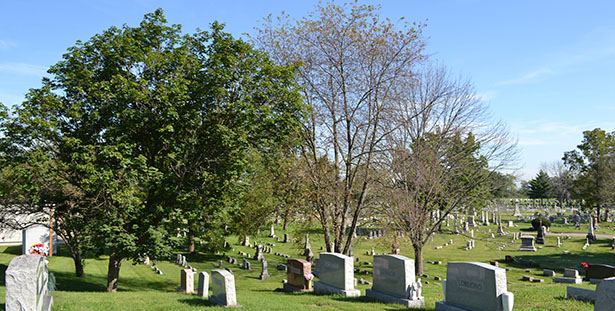
By John Stegeman
The Catholic Telegraph
HAMILTON — For more than a century mourners at St. Stephen and St. Mary cemeteries in Hamilton, Ohio have come to pay their respects to the deceased among a diverse canopy of trees. Because of an insect less than half an inch in length, that canopy is significantly thinner now and parts of the picturesque and historic cemeteries are beginning to look barren.
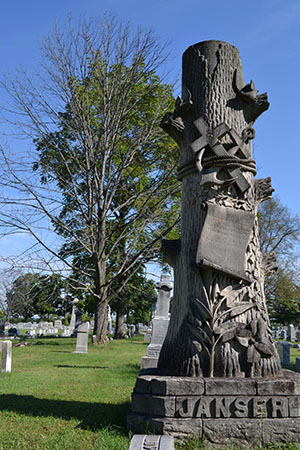
Faced with the loss of at least 40 ash trees to the Emerald Ash Borer (EAB), a small invasive and aggressive beetle, St. Stephen Cemetery has had to put future projects and improvements on hold. Last year the cemetery spent more than $10,000 on tree removal related to the EAB and this year removing the infected trees has cost more than $15,000. To help with the removal an planting of replacement trees, the St. Stephen Cemetery Fund has been established. Roughly $2,000 had been pledged to the cause as of Sept. 9, but more is needed.
St. Stephen and St. Mary’s Cemeteries are jointly operated as the parish cemeteries of St. Julie Billiart Catholic Parish in Hamilton. The ash tree removal has begun at St. Stephen first, but many trees at St. Mary are infected as well. More than 32,000 people are interred between the two locations.
St. Stephen Cemetery’s tree removal has drawn the attention of mourners, many of whom use trees as a marker to help locate a loved one’s grave.
“Everybody loves trees and they always want to know when we’re going to replace them,” said Darelene Giuliano, office manager for St. Mary/St. Stephen Cemeteries. “But with the cost of taking the trees down, to replace them is a real budget crunch for us.”
What is the Emerald Ash Borer & what does it do?
The EAB was accidentally introduced to the United States from Asia in the Detroit, Mich. area around 2002. Since then, millions of infected trees have died as far north as Canada and as far south as the Great Smoky Mountains. According to the latest map from the Ohio Department of Agriculture, Adams County is the only county in the Archdiocese of Cincinnati without the EAB. The beetle in its adult form is emerald in color, nearly a half-inch to an inch long and shaped like a bullet. The adult form of the insect isn’t harmful to trees.
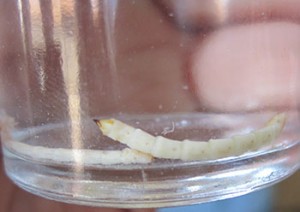
“What actually damages the tree is the larval phase,” said Ryan McEwan, associate professor of ecology at the University of Dayton. “The larvae are about an inch long and it emerges into this beetle that flies away. (The larvae) develop under the bark and these little grub-like organisms eat the inside of the tree, the phloem part of the tree which has nutrients, not the heartwood. Its the exterior of the tree right under the bark and that’s what kills the tree. It cuts off the ability of the tree to deliver nutrients and water up and down, effectively shutting off the vascular system of the tree.”
Once infected, a tree will begin to thin out along the top canopy. A third to half of the branches will be dead in a year and most of the canopy will be dead within two years. A look beneath the bark on most infected or dead ash trees will show long, snaking lines that show the path the borer took as it helped to kill the tree. The EAB emerges from the tree by making small “D” shaped holes and flying away.
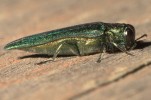
Often ash trees will grow sprouts off the trunk once the upper part of a tree dies.
Other Cemeteries are having the same problem
At St. Stephen, dead and dying ash trees marked with an “X” for removal dot the otherwise thriving landscape. Where removal has taken place, a patch of mulch is all that remains of very old trees among very old headstones.
“A lot of the trees that have been stricken with the ash borer were very old trees in old sections,” Giuliano said. “There isn’t much activity in those sections but those trees made it look very serene. Now it’s bare, wide open. There’s no look to it but all headstones.”
Other cemeteries, like the Mt. Washington Cemetery in Mt. Washington, have had the same problem. The Cincinnati Enquirer reported in July that a non-profit association was soliciting donations to offset their cost of removal citing safety issues.
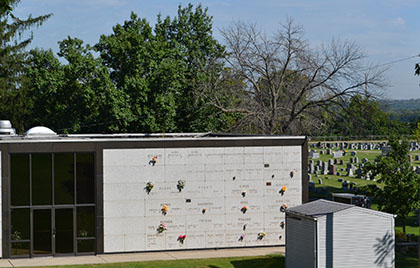
The Catholic Cemeteries of the Archdiocese of Chicago have a full web page dedicated to explaining the risk posed by the EAB and what can be done about the issue. Chicago’s policy has been to removed an infected tree as soon as it shows symptoms. At St. Stephen the trees are removed as the budget allows.
No easy solutions
Discussing the situation of the North American ash trees in the context of a cemetery is appropriate. McEwan wasn’t willing to say the situation is completely hopeless, but he acknowledged it is “not good.”
“The mortality rates on ash trees are nearly 100 percent,” McEwan said. “What that means here is that if you’ve got an ash tree in your yard or in the forrest or wherever you’re managing a landscape, its pretty much doomed in the next five years. They don’t miss any at certain levels of the infestation. The trees here don’t have any resistance.”
For an individual homeowner, or a property with a limited number of ash trees, a systemic insecticide exists that has been shown to work. The problem is that treatments are expensive and not practical on large scales. While woodpeckers are known to eat the EAB, they are not enough to stem the tide either, McEwan said.
While no solutions exist to stop the advance of the EAB, it can be slowed. On it’s own, an EAB will only travel up to a half mile from the tree it hatches from. With modern transport though, it goes much further.
“Don’t move firewood. That’s the main thing we can do right now,” McEwan said. “Theoretically, it would take a very long time for it to get from Detroit to Dayton, Ohio, 50 years or so. But if you transport it in your truck… now you’ve just taken the dispersal of how far the thing can fly and multiplied that by 50 in one year.”
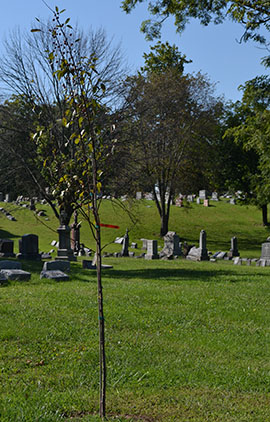
Another solution is the help the insect’s food supply to run out. Cutting down infected trees is recommended by many experts, both as a safety measure and to help stop the advance. Additionally, McEwan noted that EAB only attacks the genus fraxinus, ash trees. Maples, oaks, walnuts, elms etc. are safe to plant.
What’s next?
At St. Stephen, new trees are already being planted. Young maples, oaks and crabapple trees are beginning to replace their deceased ash predecessors, but it will take some time before they provide the shade and look of what came before. The cost of the removal and replacement led the cemetery to reach out to area parishes with a bulletin announcement seeking donations. All donations to the St. Stephen Cemetery Tree Fund are tax deductible and materials provided by the cemetery said 100 percent of all funds will be used for removal and replanting.
To donate, make checks payable to the St. Stephen Cemetery Tree Fund and mail to St. Stephen Cemetery, 1314 Greenwood Avenue, Hamilton, Ohio 45011. For more information, contact the office at (513) 737-1600.
Posted Sept. 9, 2014
This story is a www.TheCatholicTelegraph.com exclusive.


